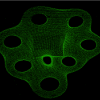Hey, I'm trying to render to multiple targets using a frame buffer object, but as of now only the first target is being rendered to. If I render either of the other two buffers to the screen it's a white wash.
It does work for the first and as far as I can tell I'm not treating the other two targets any differently, so I'm having a bit of trouble deciphering where the root of this problem is. If anyone could point me in the right direction that would be great!
Oh and I'm using the fixed function pipeline as a placeholder to draw the texture since it was a quick solution.
Renderer:
public class DeferredRenderer {
public static final int POSITION_BUFFER_BINDING = 0;
public static final int NORMAL_BUFFER_BINDING = 1;
public static final int DIFFUSE_BUFFER_BINDING = 2;
public static final int SCREEN_BUFFER_BINDING = 3;
private final Texture positionBuffer;
private final Texture normalBuffer;
private final Texture diffuseBuffer;
private final Texture screenTexture;
private final FBO fbo;
private final RBO fboDepthBuffer;
public DeferredRenderer(final int width, final int height) throws GraphicsException{
GL11.glEnable(GL11.GL_DEPTH_TEST);
GL11.glEnable(GL11.GL_CULL_FACE);
positionBuffer = new Texture(width, height, POSITION_BUFFER_BINDING, OGLColorType.RGBA16F);
normalBuffer = new Texture(width, height, NORMAL_BUFFER_BINDING, OGLColorType.RGBA16F);
diffuseBuffer = new Texture(width, height, DIFFUSE_BUFFER_BINDING, OGLColorType.RGBA16F);
screenTexture = new Texture(width, height, SCREEN_BUFFER_BINDING, OGLColorType.RGBA8);
fbo = new FBO();
fboDepthBuffer = new RBO(width, height, AttachmentType.DEPTH_ATTACHMENT);
fbo.bind();
fboDepthBuffer.bind();
positionBuffer.attachToFBO(AttachmentType.COLOR_ATTACHMENT0);
normalBuffer.attachToFBO(AttachmentType.COLOR_ATTACHMENT1);
diffuseBuffer.attachToFBO(AttachmentType.COLOR_ATTACHMENT2);
final IntBuffer buffer = BufferUtils.createIntBuffer(3);
buffer.put(0, AttachmentType.COLOR_ATTACHMENT0.ID);
buffer.put(1, AttachmentType.COLOR_ATTACHMENT1.ID);
buffer.put(2, AttachmentType.COLOR_ATTACHMENT2.ID);
buffer.rewind();
// Creates an array of buffers that the fragment shader will output to
GL20.glDrawBuffers(buffer);
if(!fbo.checkForErrors()) {
throw new GraphicsException("Could not compile FBO");
}
fboDepthBuffer.unbind();
fbo.unbind();
}
public void beginDrawing() {
fbo.bind();
GL11.glClear(GL11.GL_COLOR_BUFFER_BIT | GL11.GL_DEPTH_BUFFER_BIT);
}
public void endDrawing() {
fbo.unbind();
diffuseBuffer.bind();
GL11.glBegin(GL11.GL_QUADS);
GL11.glTexCoord2f(0.0f, 0.0f);
GL11.glVertex3f(-1.0f, -1.0f, 0.0f); // The bottom left corner
GL11.glTexCoord2f(0.0f, 1.0f);
GL11.glVertex3f(-1.0f, 1.0f, 0.0f); // The top left corner
GL11.glTexCoord2f(1.0f, 1.0f);
GL11.glVertex3f(1.0f, 1.0f, 0.0f); // The top right corner
GL11.glTexCoord2f(1.0f, 0.0f);
GL11.glVertex3f(1.0f, -1.0f, 0.0f); // The bottom right corner
GL11.glEnd();
diffuseBuffer.unbind();
}
public void destroy() {
positionBuffer.destroy();
normalBuffer.destroy();
diffuseBuffer.destroy();
}
}
Vertex shader:
#version 330 core
uniform mat4 u_projectionMatrix;
uniform mat4 u_viewMatrix;
uniform mat4 u_modelMatrix;
in vec4 in_Position;
in vec3 in_Normal;
in vec2 in_TextureCoord;
out vec4 pass_Position;
out vec4 pass_Normal;
out vec2 pass_TextureCoord;
void main(void) {
mat4 mvp = u_projectionMatrix * u_viewMatrix * u_modelMatrix;
pass_Position = mvp * in_Position;
pass_Normal = vec4(normalize(mat3(mvp) * in_Normal), 1);
pass_TextureCoord = in_TextureCoord;
gl_Position = mvp * in_Position;
}
Fragment shader:
(I know I'm not passing the correct values, I just want to fix this problem and pass data through all the buffers before continuing on)
#version 330 core
uniform sampler2D texture_diffuse;
in vec4 pass_Position;
in vec4 pass_Normal;
in vec2 pass_TextureCoord;
void main(void) {
vec4 texel = texture(texture_diffuse, pass_TextureCoord);
gl_FragData[0] = texel;
gl_FragData[1] = pass_Normal;
gl_FragData[2] = texel;
}






